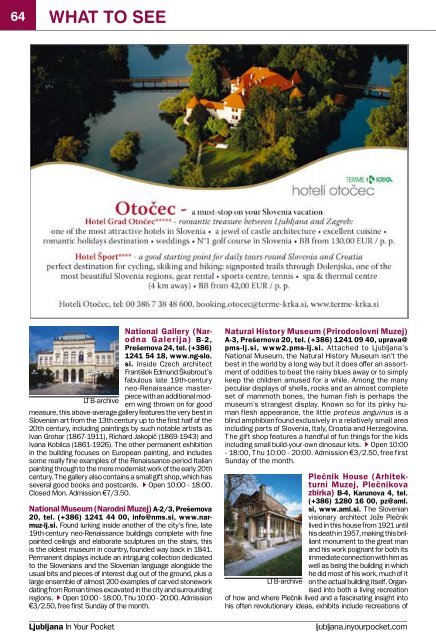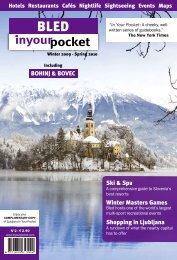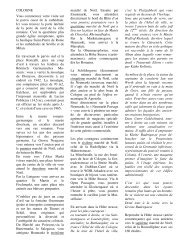Mega Center, Savska cesta 34, Kranj - Format'Age
Mega Center, Savska cesta 34, Kranj - Format'Age
Mega Center, Savska cesta 34, Kranj - Format'Age
Create successful ePaper yourself
Turn your PDF publications into a flip-book with our unique Google optimized e-Paper software.
4 whAt to see<br />
National Gallery (Narodna<br />
Galerija) B-2,<br />
Prešernova 24, tel. (+386)<br />
1241 54 18, www.ng-slo.<br />
si. Inside Czech architect<br />
František Edmund Škabrout’s<br />
fabulous late 19th-century<br />
neo-Renaissance masterpiece<br />
with an additional mod-<br />
LTB-archive<br />
ern wing thrown on for good<br />
measure, this above-average gallery features the very best in<br />
Slovenian art from the 13th century up to the first half of the<br />
20th century, including paintings by such notable artists as<br />
Ivan Grohar (1867-1911), Richard Jakopič (1869-1943) and<br />
Ivana Kobilca (1861-1926). The other permanent exhibition<br />
in the building focuses on European painting, and includes<br />
some really fine examples of the Renaissance-period Italian<br />
painting through to the more modernist work of the early 20th<br />
century. The gallery also contains a small gift shop, which has<br />
several good books and postcards. QOpen 10:00 - 18:00.<br />
Closed Mon. Admission €7/3.50.<br />
National Museum (Narodni Muzej) A-2/3, Prešernova<br />
20, tel. (+386) 1241 44 00, info@nms.si, www.narmuz-lj.si.<br />
Found lurking inside another of the city’s fine, late<br />
19th-century neo-Renaissance buildings complete with fine<br />
painted ceilings and elaborate sculptures on the stairs, this<br />
is the oldest museum in country, founded way back in 1841.<br />
Permanent displays include an intriguing collection dedicated<br />
to the Slovenians and the Slovenian language alongside the<br />
usual bits and pieces of interest dug out of the ground, plus a<br />
large ensemble of almost 200 examples of carved stonework<br />
dating from Roman times excavated in the city and surrounding<br />
regions. QOpen 10:00 - 18:00, Thu 10:00 - 20:00. Admission<br />
€3/2.50, free first Sunday of the month.<br />
Natural History Museum (Prirodoslovni Muzej)<br />
A-3, Prešernova 20, tel. (+386) 1241 09 40, uprava@<br />
pms-lj.si, www2.pms-lj.si. Attached to Ljubljana’s<br />
National Museum, the Natural History Museum isn’t the<br />
best in the world by a long way but it does offer an assortment<br />
of oddities to beat the rainy blues away or to simply<br />
keep the children amused for a while. Among the many<br />
peculiar displays of shells, rocks and an almost complete<br />
set of mammoth bones, the human fish is perhaps the<br />
museum’s strangest display. Known so for its pinky human<br />
flesh appearance, the little proteus anguinus is a<br />
blind amphibian found exclusively in a relatively small area<br />
including parts of Slovenia, Italy, Croatia and Herzegovina.<br />
The gift shop features a handful of fun things for the kids<br />
including small build-your-own dinosaur kits. QOpen 10:00<br />
- 18:00, Thu 10:00 - 20:00. Admission €3/2.50, free first<br />
Sunday of the month.<br />
Plečnik House (Arhitekturni<br />
Muzej, Plečnikova<br />
zbirka) B-4, Karunova 4, tel.<br />
(+386) 1280 16 00, pz@aml.<br />
si, www.aml.si. The Slovenian<br />
visionary architect Jože Plečnik<br />
lived in this house from 1921 until<br />
his death in 1957, making this brilliant<br />
monument to the great man<br />
and his work poignant for both its<br />
immediate connection with him as<br />
well as being the building in which<br />
he did most of his work, much of it<br />
LTB-archive on the actual building itself. Organised<br />
into both a living recreation<br />
of how and where Plečnik lived and a fascinating insight into<br />
his often revolutionary ideas, exhibits include recreations of<br />
Ljubljana In Your Pocket ljubljana.inyourpocket.com<br />
everything from his kitchen, bedroom, bathroom and countless<br />
examples of original drawings and models. The museum can<br />
only be visited as part of a guided tour. Q Mon & Fri 10:00-<br />
15:00, Tues, Wed & Thu 10:00-18:00, Sat 09:00-15:00, Sun<br />
and holidays closed.There are only guided visits on the hour.<br />
Up to 7 visitors at a time allowed. Last tour is one hour before<br />
closing time. Admission €4/2.<br />
Railway Museum (Železniški Muzej) B-1, Parmova<br />
35, tel. (+386) 1291 26 41. Housed primarily in a<br />
wonderful semicircular brick locomotive shed, the current<br />
incarnation of this excellent museum dates from 2004<br />
and offers an exceptional glimpse behind the history of<br />
the technology, culture and people of the nation’s railway<br />
heritage. In the shed find a chorusline of vast old steam<br />
locomotives, the oldest dating from 1861, whilst another<br />
building plays host to several rooms of signal equipment,<br />
railway eccentricities, uniforms, a recreation of old station<br />
master’s office and, up a wiggly spiral staircase, a small art<br />
gallery featuring the railway-related paintings of one of the<br />
museum’s former directors. Outside find even more exhibits<br />
from rusting trains to a small scale model of a viaduct. This<br />
highly recommended museum will keep boys of all ages occupied<br />
for a pleasant hour or more. QOpen 10:00 - 18:00.<br />
Closed Mon. Admission €3/2.<br />
Slovene Ethnographic Museum (Etnografski<br />
Muzej) D-2, Metelkova 2, tel. (+386) 1300 87 00,<br />
etnomuz@etno-muzej.si, www.etno-muzej.si. The<br />
impressive Ethnographic Museum’s aims are to the link<br />
past and present, different cultures as well as nature<br />
and civilisation in creative and imaginative ways through<br />
the use of both exhibitions and workshops. Whatever<br />
the exhibitions on display, whether about Slovenian folk<br />
music, traditional horsehair sieves or any number of other<br />
topics, the clever use of materials, interactive displays<br />
and an excellent choice of English descriptions makes<br />
this place an essential place to visit. Find the entrance in<br />
the large square at the back of the building and be sure<br />
to take a look at the huge black and white photographs<br />
incorporated into the pillar designs in the main entrance<br />
hall. QOpen 10:00 - 18:00. Closed Mon. Admission<br />
€4.50/2.50 (adults/students).<br />
Parks & Gardens<br />
Botanical Gardens (Botanični Vrt) H-3, Ižanska 15,<br />
tel. (+386) 1427 12 80, botanicni.vrt@siol.net, www.<br />
botanicni-vrt.si. Nearly 200 years old, this garden is part of the<br />
biology department of Ljubljana University and has 2 hectares of<br />
protected landscape. Guided tours of groups over 15 people are<br />
possible for a small fee and when booked 10 days in advance. Q<br />
Open 07:00-19:00, Jul-Aug 07:00-20:00. Admission free.<br />
Ljubljana Zoo (Živalski Vrt) G/H-2, Večna Pot 70, tel.<br />
(+386) 1244 21 88, www.zoo.si. A large complex with a<br />
good variety of native and foreign animals. An excellent day<br />
out for the kids, and educative for parents too. Only a 20<br />
minute walk from the city centre or a short ride on bus 23.<br />
Guided night tours are available on Thursdays and Saturdays<br />
from 21:00-23:00. Closes one hour earlier in September. QOpen<br />
09:00 - 19:00. Admission: €6/4.50/3.55/1 for adults/<br />
students/pre-schoolers/pets, free for children under 2.<br />
Squares<br />
Trg Republike (Republic Square) A/B-3. The political<br />
centre of modern Slovenia, this square houses the brutalist<br />
1960 parliament building, two equally delicate office towers<br />
and the Cankarjev dom centre.<br />
ljubljana.inyourpocket.com<br />
whAt to see<br />
Around Ljubljana<br />
Otočec Castle Otočec 8222, tel. (+386) 73 84<br />
86 00, fax (+386) 73 84 87 05, www.terme-krka.<br />
si. Photogenically located on an island in the middle of<br />
the river Krka , Otočec Castle dates back to at least<br />
1252, when it first found its way into the anals of history<br />
as a property of the Counts of Višnja Gora. Over the<br />
next 700 years ownership passed through a mélange<br />
of distinguished hands, including kings, noble families<br />
and even the Catholic Church. The castle has seen many<br />
architectural changes over the years, with minor alterations<br />
going on well into the 19th century. However, it can<br />
generally be said to have a Baroque style. After being<br />
largely destroyed by the Partisans during the Second<br />
World War, it has since been rebuilt and now serves as<br />
a five-star luxury hotel owned and operated by the good<br />
people at Terme Krka.<br />
Postojna Cave (Postojnska Jama) Jamska<br />
30, tel. (+386) 1700 01 00, fax (+386) 1700 01<br />
30, info@turizem-kras.si, www.turizem-kras.<br />
si. The largest cave in Europe, words on a page can<br />
hardly do justice to the majesty of Postojna. So far,<br />
more than 20 kilometres of galleries have been found,<br />
of which barely a fraction are open to the public. All<br />
the same, a visit here still takes up much of a morning<br />
or an afternoon, as you make your way through<br />
the most spectacular parts of the cave, at first by<br />
a dinky little narrow-gauge train, and then on foot.<br />
Formed over millions of years by the Pivka river, the<br />
cave was discovered in the 17th century, though never<br />
properly explored until the early 1800s. They opened<br />
as a tourist attraction in 1819, with Franz I, Emperor of<br />
Austria, among the first to visit. Bizarrely, so popular<br />
did the caves become that electric lights were fitted<br />
in 1884: some years before such technology was<br />
first deployed in Ljubljana itself. Highlights of the cave<br />
include the enormous stalactites and stalagmites,<br />
and the quite sensational concert hall, which can (and<br />
does) hold 10,000 people. The acoustics down here<br />
are said to be sensational. Note that the temperature<br />
of the cave is a chilly 10 degrees Centigrade, so bring<br />
a jumper. The caves are also home to olms (or white<br />
salamanders), a blind amphibian endemic to the subterranean<br />
waters of caves of this part of Europe. The<br />
olms can sometimes - though not always - be seen<br />
in some of the pools of water as you make your way<br />
around the cave. Though blind they are sensitive to<br />
flash photography and if you do spot one you should<br />
refrain from taking any photos. You will be well and<br />
truly told off if you do. To get to Postojna, take any<br />
train or bus from Ljubljana heading for the coast, and<br />
jump off at Postojna.<br />
Velika Planina Tel. (+386) 1832 72 58/(+386)<br />
51 <strong>34</strong> 14 06, info@velikaplanina.si, www.velikaplanina.si/Home.<br />
Rising 1666 metres into the Julian<br />
Alps, the Velika Planina nature park is only a short drive<br />
north of Ljubljana and makes a great day trip for outdoor<br />
enthusiasts. While the rolling hills are criss-crossed<br />
with hundreds of kilometres of scenic hiking trails and<br />
mountain cycling paths, the most unique attraction has to<br />
be a traditional dairy herdsmen’s settlement that is fullyfunctioning<br />
and open to visitors from June to September.<br />
A cable car will bear the burden of transporting you up the<br />
mountain, and there’s even a handful of traditional dining<br />
and accommodation options once your there.<br />
December 2009 - January 2010





